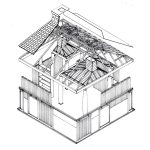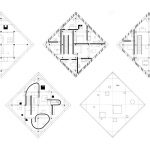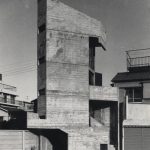The second house Kazuo Shinohara designed for Japanese poet Shuntaro Tanikawa, lies in the mountains in Nagano prefecture.
Built in 1974, this summer house materializes the act of covering a piece of earth, making it an inhabitation only by means of a roof protecting the dirt soil of the ground. The house lies on a slope in a middle of a wood and grows through an exposed timber frame structure which supports a large pitched roof. Under the roof, a minimal section of the house located on a side hosts some specific living functions concentrated on two floors: a bathroom, a kitchen, a bedroom and a staircase. This section lies in parallel to the main “earth room” (or “summer room”) and overlooks it.
From the outside, the house looks unassuming, showing a traditional shape and wooden coating. In the inside, it reveals a space ambiguosly suspended between a natural and an architectural landscape with no specific function, where the white coated roof covers horizontally a dark soil and the gentle slope of the ground is contrasted by the geometrical preciseness of the roof and the structure.
Apparently Tanikawa wrote a poem to inspire the project and gave the architect a brief through the language he was most confident with. He needed a “fortress”, a place of calm, to live in with his family and conduct his work.
More on Shinohara’s work on SOCKS: The Overturn of the Traditional Model in Two Houses by Kazuo Shinohara and Kengo Kuma
Sources:
Further reading:






For me the division of space of this project was strange.
The idea of division in architecture is strange too. We just take it for granted today, and don’t realize it can be contested.
Is there a bathroom, kitchen, and place to sleep on any single floor? I can’t tell by looking